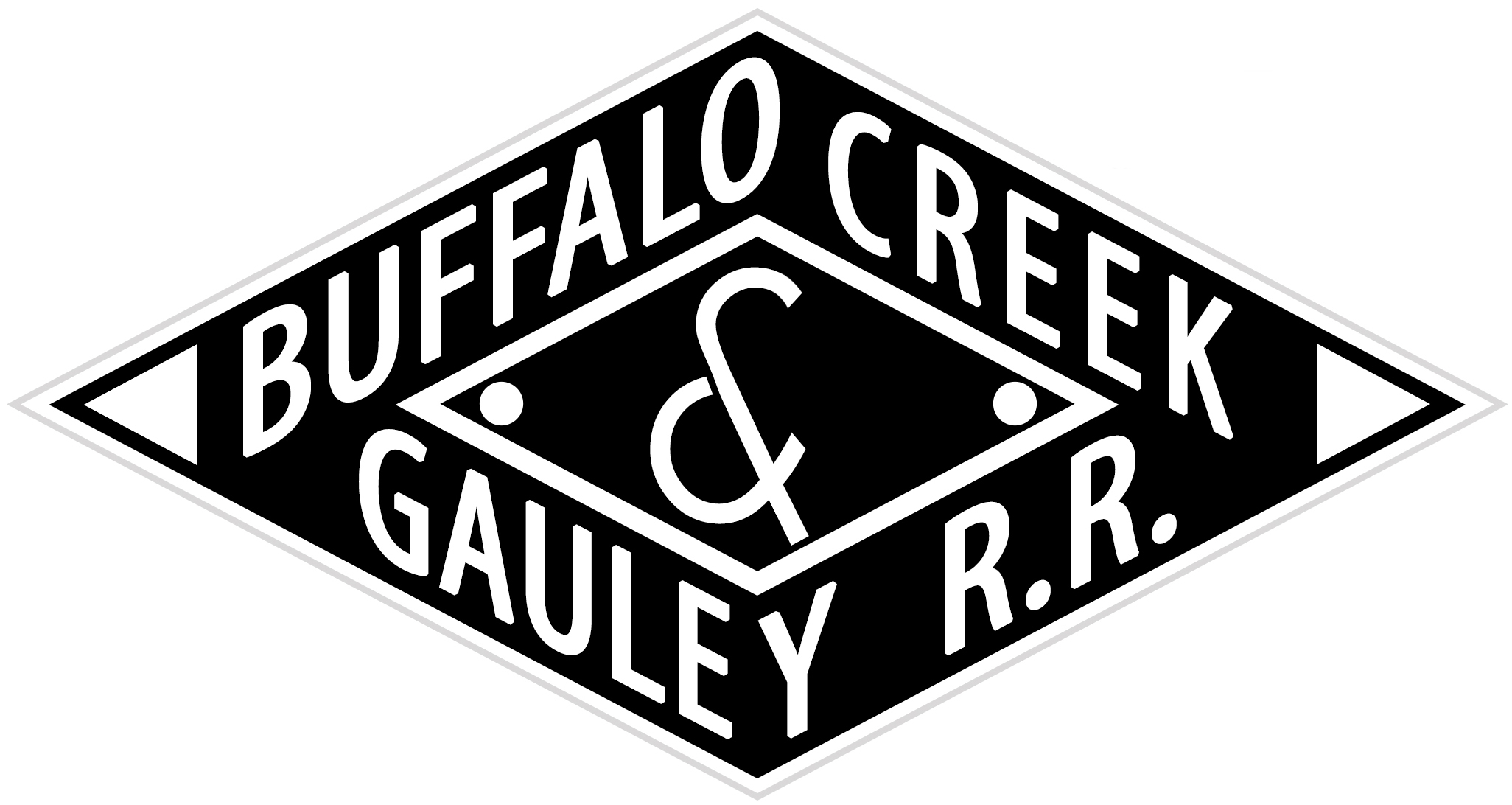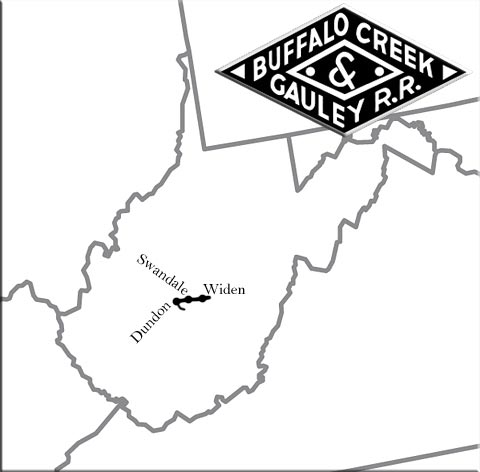Buffalo Creek & Gauley Railroad: Map, Roster, Logo, Photos
Last revised: August 22, 2024
By: Adam Burns
Positioned amidst the undulating hills and secluded hollows of West Virginia lay the Buffalo Creek and Gauley Railroad. With its modest length of just 19 miles, it may have been easy to overlook this short line railway. Yet despite its humble stature, it achieved the status of a legendary entity within the railroad industry.
The railway held the unique distinction of being the final sanctuary of the classic steam locomotive, still staunchly performing regular service in the U.S.
This best kept secret of the rail industry drew ardent rail enthusiasts and cultural historians alike. These aficionados gathered at the quaint hamlets of Dundon and Widen nestled in Clay County, drawn by the allure of witnessing the steadfast Consolidations in action. This enduring spirit of history and nostalgia is what made the BC&G so distinct and celebrated.
Unfortunately, when the coal mines and lumber business dried up in the 1960s, so did the railroad and the last regular scheduled freight train departed for the B&O interchange at Dundon on February 27, 1965.
While the railroad was revived twice during the 1970s and 1990s, it sat dormant and abandoned for years. In 2005 the Buffalo Creek and Gauley Railroad Co-Operative was formed to revive the entire railroad between Dundon and Widen as a tourist railroad.
However, these project also ultimately failed. The West Virginia State Rail Authority would later purchase the property in December, 2020 and as of the spring of 2024 efforts are underway to restore the railroad for railbiking via Rail Explorers.
Photos
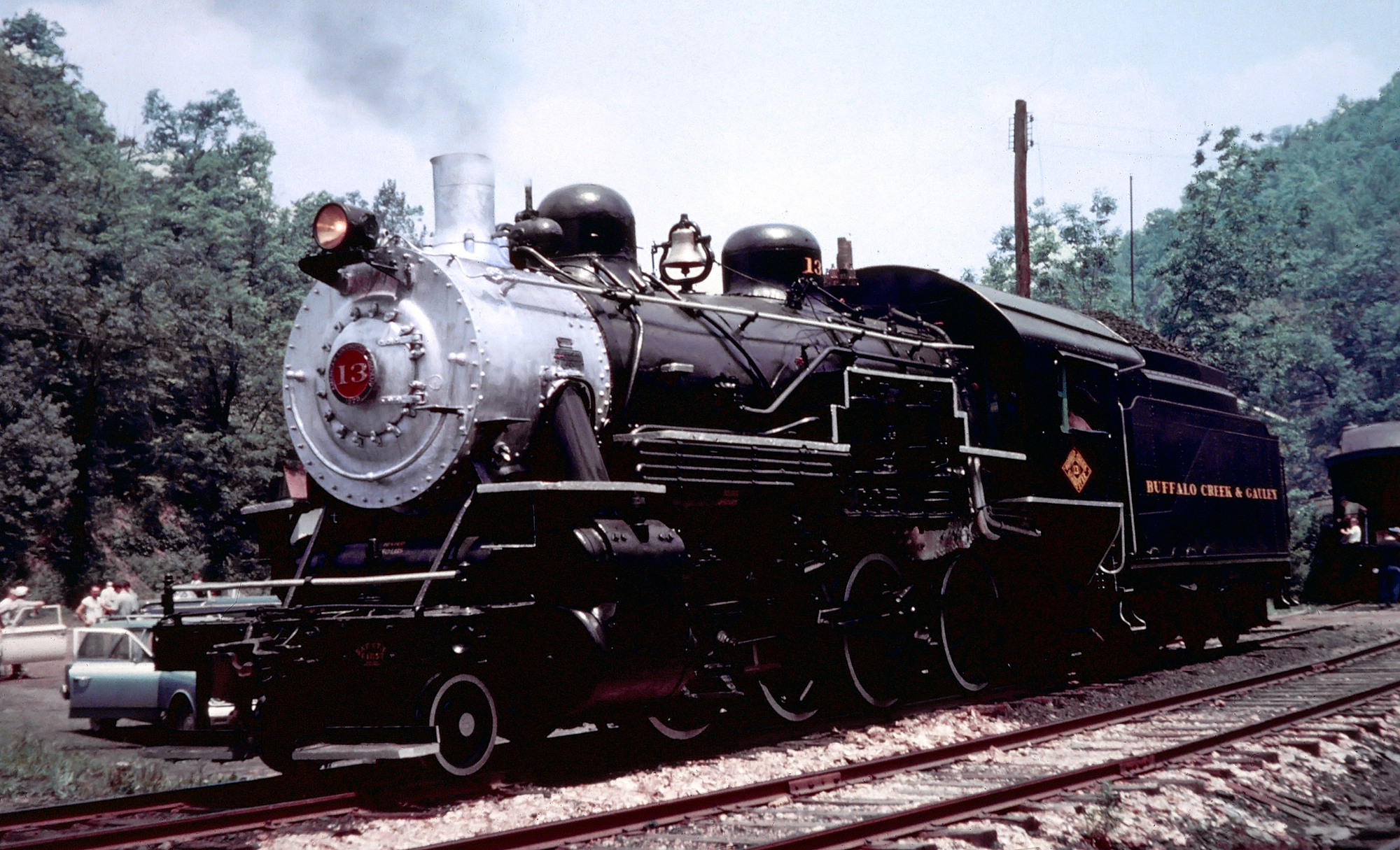 Buffalo Creek & Gauley 2-8-0 #13 is photographed here between excursion runs at Widen, West Virginia, circa 1963. Fred Byerly photo. American-Rails.com collection.
Buffalo Creek & Gauley 2-8-0 #13 is photographed here between excursion runs at Widen, West Virginia, circa 1963. Fred Byerly photo. American-Rails.com collection.History
It was in 1904 that the Elk River Coal & Lumber Company, brought to life under the visionary leadership of Joseph Garner Bradley, chartered the BC&G. Its inception was destined to transport the company's burgeoning coal and lumber interests within the region.
Initially, the railroad was conceived to be a significant venture, ambitiously extending over 100 miles to unite Dundon in Clay County with Huttonsville in Randolph County. However, these grand plans never came to fruition. Despite the high aspirations, railroad's reach was significantly curtailed, stretching a mere 18 miles from Dundon to Widen in the east.
At A Glance
Dundon - Swandale - Widen, West Virginia (Main Line) Dundon - Lily Fork, West Virginia (Elk River Coal & Lumber Logging Branch: 9 miles) | |
Expansion
About seven years after the railroad was chartered it finished its farthest stretch eastward to Widen in 1911. That same year Rich Run Mine was opened giving the BC&G another source of freight.
Logo
In 1918 the sawmill at
Swandale, located about halfway between Dundon and Widen, opened. These
vast sawmill operations, along with the coal mine at Rich Run (near Widen), were the BC&G's primary source of traffic for much of its
existence.
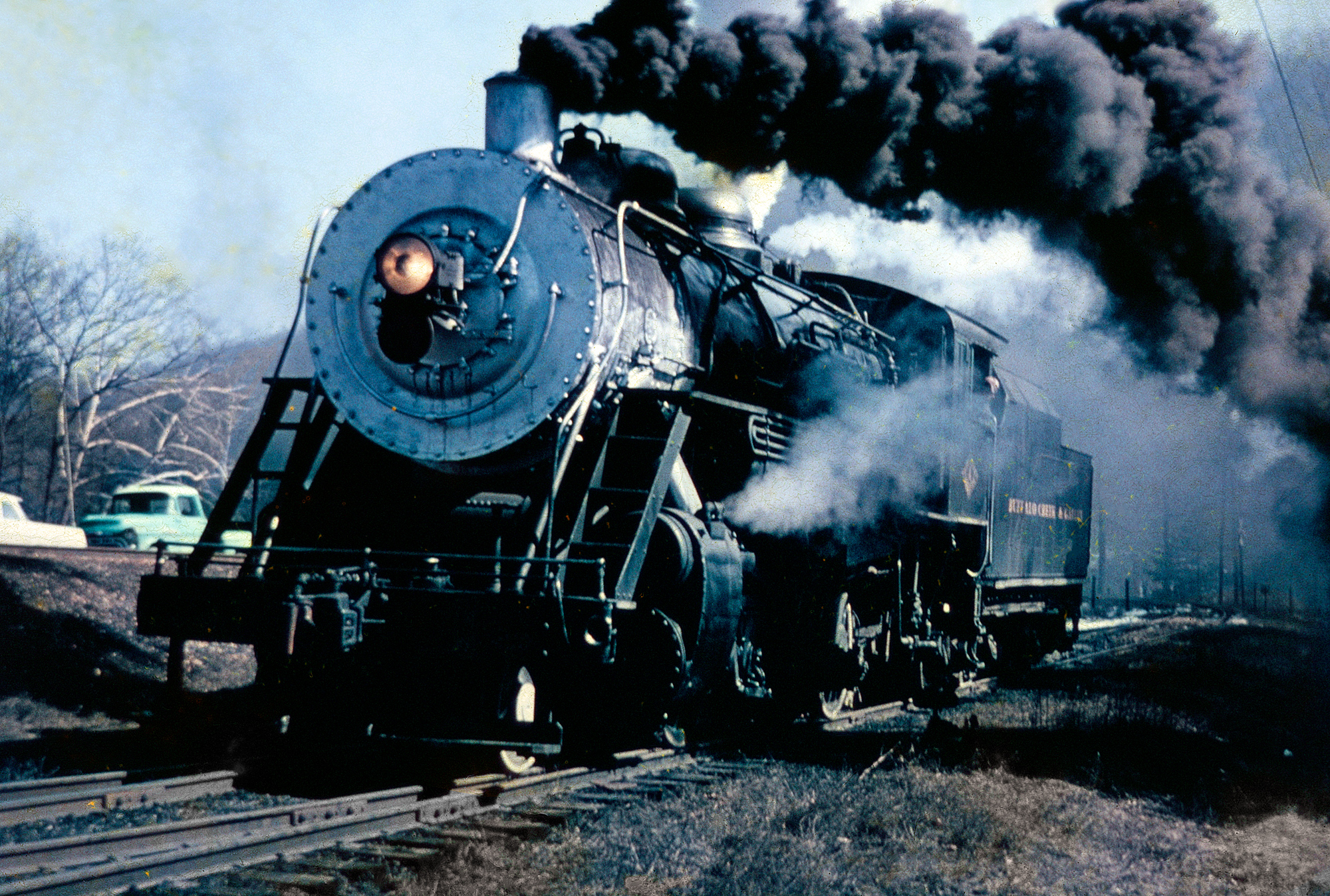 Buffalo Creek & Gauley 2-8-0 #4 steams up for railfans during a day of photo shoots and run-bys and the fall of 1964. Larry Fellure photo. American-Rails.com collection.
Buffalo Creek & Gauley 2-8-0 #4 steams up for railfans during a day of photo shoots and run-bys and the fall of 1964. Larry Fellure photo. American-Rails.com collection.Interestingly, of the BC&G's steam locomotives only four were ever purchased new, 2-8-0 Consolidation #4 from Baldwin Locomotive Works in 1926, and three Climaxes.
Of note, the BC&G did roster a few diesels including a Plymouth 44-Tonner, Whitcomb 65-Tonner, and even an Alco S1.
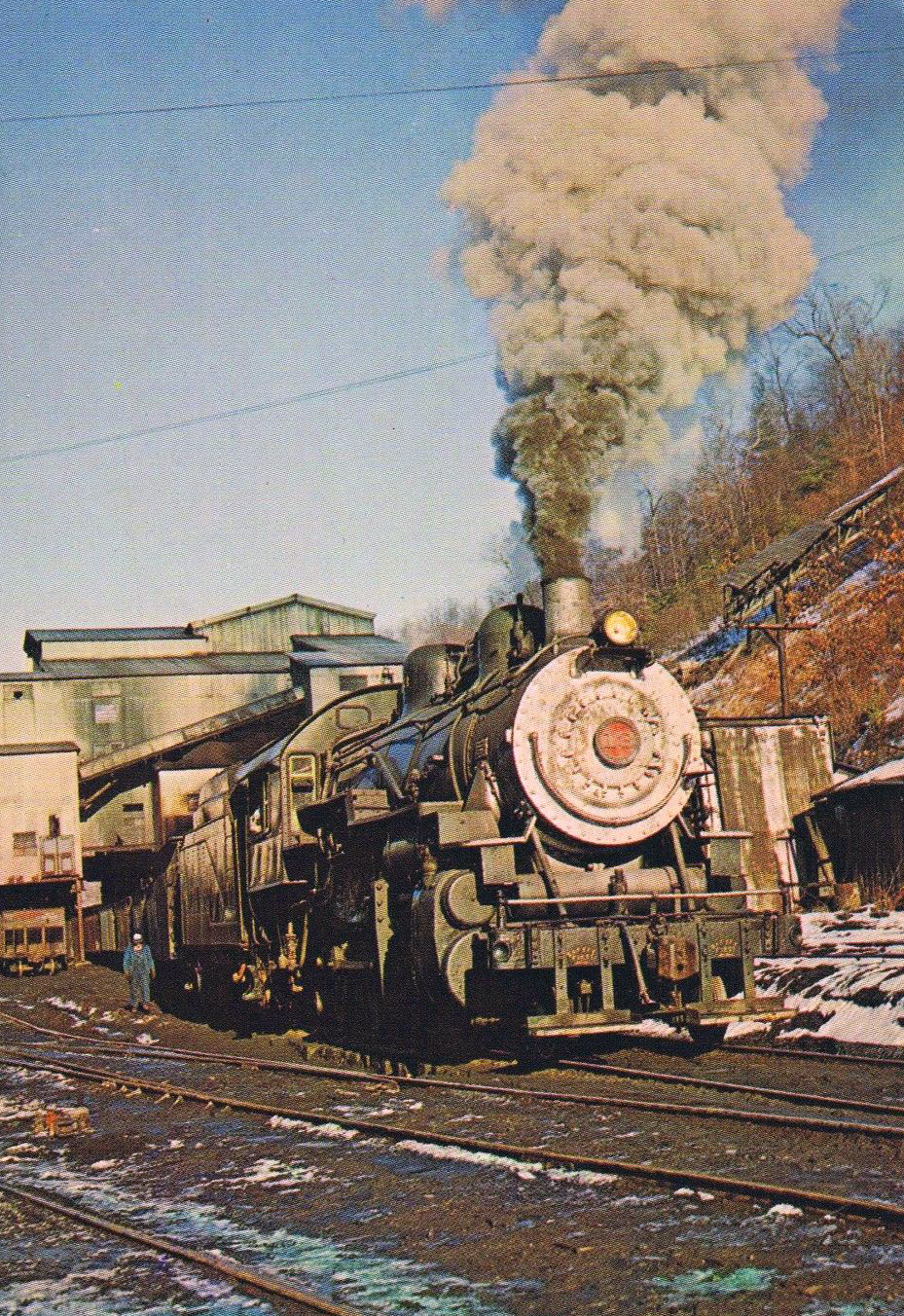 Buffalo Creek & Gauley 2-8-0 #13 is at Widen, West Virginia with the railroad's last run as the Consolidation leads a clean-up train with 99 loads and a trailing caboose. Michael Eagleson photo.
Buffalo Creek & Gauley 2-8-0 #13 is at Widen, West Virginia with the railroad's last run as the Consolidation leads a clean-up train with 99 loads and a trailing caboose. Michael Eagleson photo.Locomotive Roster
Steam Locomotives
Climax (Two Truck), E-1 Through E-3: Purchased new.
Climax (Three Truck), E-4: Purchased second-hand.
4-4-0 American #1: Purchased second-hand from the Baltimore & Ohio Railroad.
2-8-0 Consolidation #2: Purchased second-hand from the Baltimore & Ohio Railroad.
2-8-0 Consolidation #3: Purchased second-hand from the Baltimore & Ohio Railroad.
2-8-0 Consolidation #4: Purchased new from Baldwin in 1926.
2-8-0 Consolidation #5: Purchased second-hand from the Chesapeake & Ohio Railway.
2-8-0 Consolidation #6: Purchased second-hand from the Baltimore & Ohio Railroad.
2-8-0 Consolidation #7: Purchased second-hand from the Baltimore & Ohio Railroad.
0-6-0 Switcher #8: The smallest engine ever rostered by the BC&G, it was acquired in 1945 and retired just five years later in 1950.
2-8-2 Mikado #9: Purchased second-hand from the Kelley's Creek & Northwestern Railroad.
2-8-2 Mikado #10: Purchased second-hand.
2-8-2 Mikado #11: Purchased second-hand.
Shay (Three-Truck) #12: Purchased second-hand.
2-8-0 Consolidation #13: Purchased second-hand from the Kelley's Creek & Northwestern Railroad.
2-8-0 Consolidation #14: Purchased second-hand from the Kelley's Creek & Northwestern Railroad.
2-8-2 Mikado #15-#17: Purchased second-hand.
Shay (Three-Truck) #18-#19: Purchased second-hand.
Diesel Locomotives
Alco S1 #1: Purchased second-hand.
Plymouth 44-Tonner #20: Purchased second-hand.
Whitcomb 65-Tonner #20: Purchased second-hand.
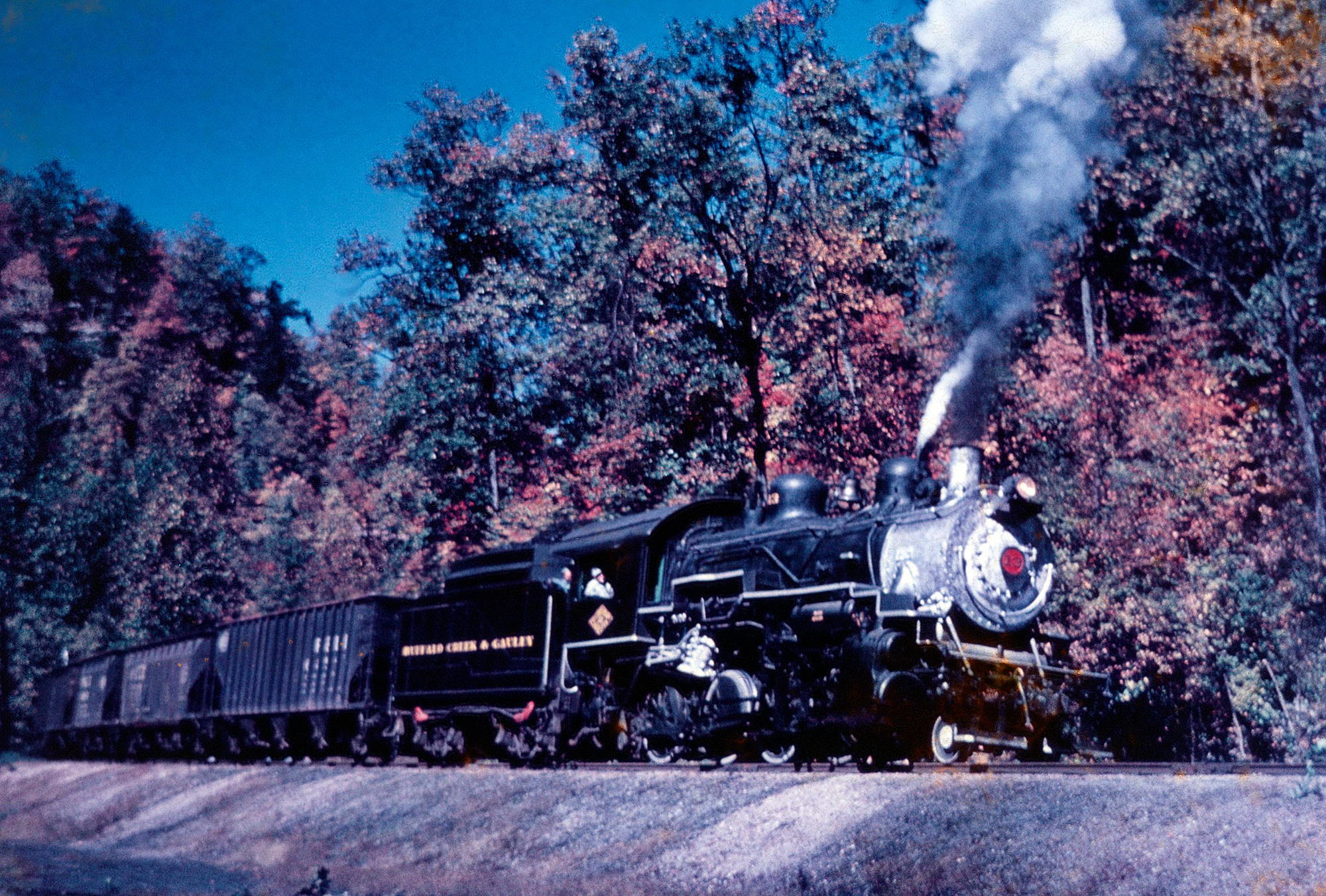 Buffalo Creek & Gauley 2-8-0 #13 pulls hoppers on the main line at Dundon, West Virginia in the fall of 1964. Larry Fellure photo. American-Rails.com collection.
Buffalo Creek & Gauley 2-8-0 #13 pulls hoppers on the main line at Dundon, West Virginia in the fall of 1964. Larry Fellure photo. American-Rails.com collection.However, their fortunes took a downward turn; facing a mounting tide of financial losses, in 1958, the ERC&L, along with all its subsidiary operations such as the BC&G, were sold off to the Clinchfield Coal Company.
This latest steward of the BC&G subsequently sold the mill to W.M. Ritter Lumber, and, keeping the wheels of the railroad turning, leased its operations to the aforementioned lumber company.
Despite these changes, the railroad's fortunes did not improve. A significant setback occurred in 1963 when the Rich Run Mine ceased operations.
A mere two years later, the final procession of finished lumber products exited Swandale, its destination being the B&O interchange at Dundon. Yet, the intriguing facet of the BC&G's history is that despite these events, they did not signify the end of its journey, but rather another twist in its captivating narrative.
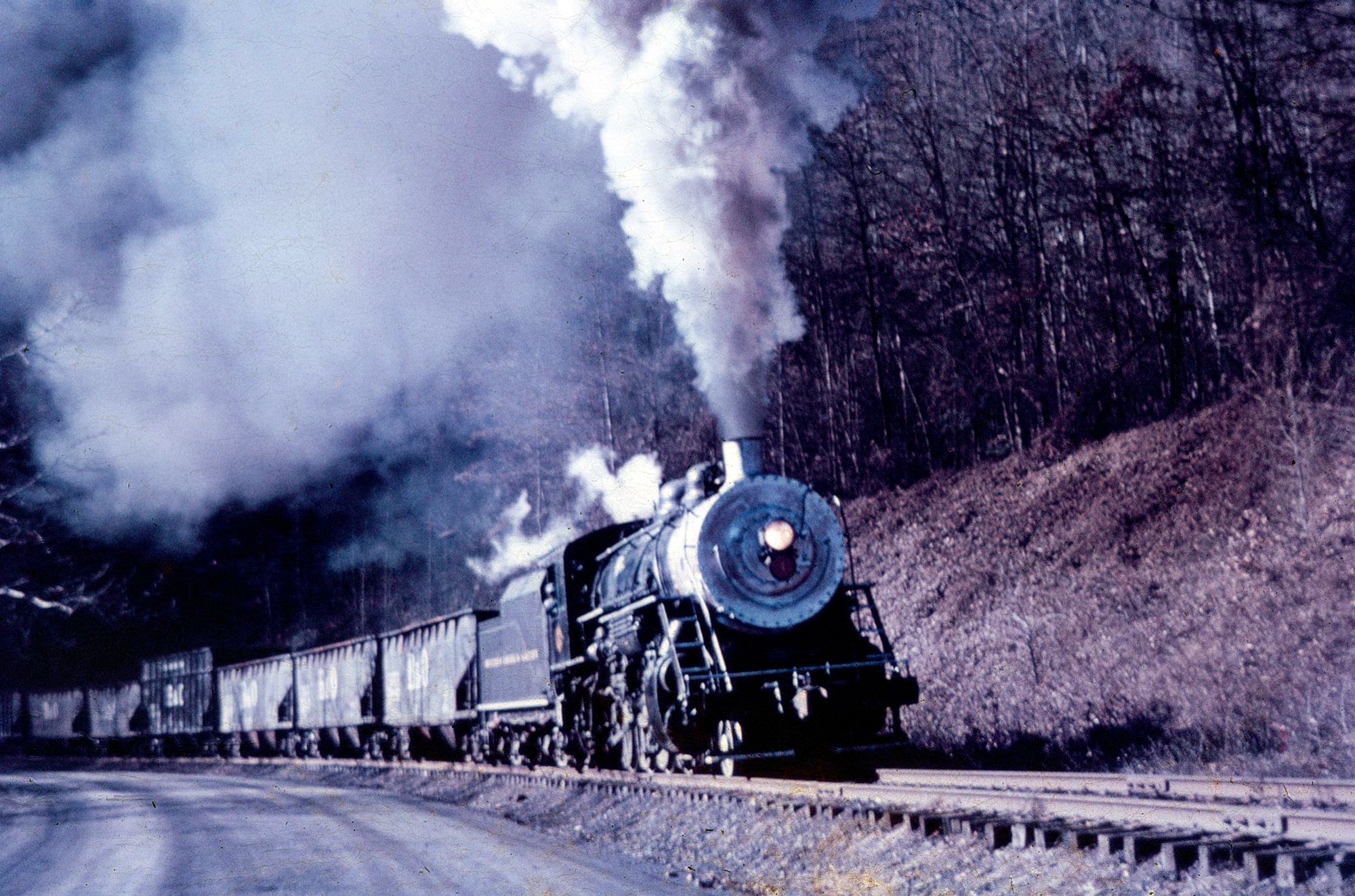 Buffalo Creek & Gauley 2-8-0 #4 pulls a cut of empty hoppers, and even an empty woodchip car, uphill west of Swandale, West Virginia in the fall of 1964. Larry Fellure photo. American-Rails.com collection.
Buffalo Creek & Gauley 2-8-0 #4 pulls a cut of empty hoppers, and even an empty woodchip car, uphill west of Swandale, West Virginia in the fall of 1964. Larry Fellure photo. American-Rails.com collection.In 1971 the railroad was revived by the Majestic Mining Company and reopened all of the way to Widen to serve a coal mine. It originally used a 65-ton Whitcomb (#20) for power and later an Alco S-2 (#2). The Majestic Mining operations lasted until 1985 at which the old railroad once again sat dormant.
System Map
 The Buffalo Creek & Gauley provided only a very minor listing in the Official Guide. This was the railroad's 1940 listing. Author's collection.
The Buffalo Creek & Gauley provided only a very minor listing in the Official Guide. This was the railroad's 1940 listing. Author's collection.But again fate saw a future for the BC&G and in the early 1990s the Elk River Railroad, Inc. was established to serve a mine at Avoca.
To reach the mine the Elk River Railroad purchased 61 miles of the B&O's former Elk River line between Gilmer and Hartland. The company had purchased the entire line to Widen but only refurbished the tracks to Avoca.
The coal loaded was
purchased by American Electric Power
(AEP) but nearly as soon as the railroad began operations it
all came to an end in the late summer of 1999 when AEP decided the coal
was substandard.
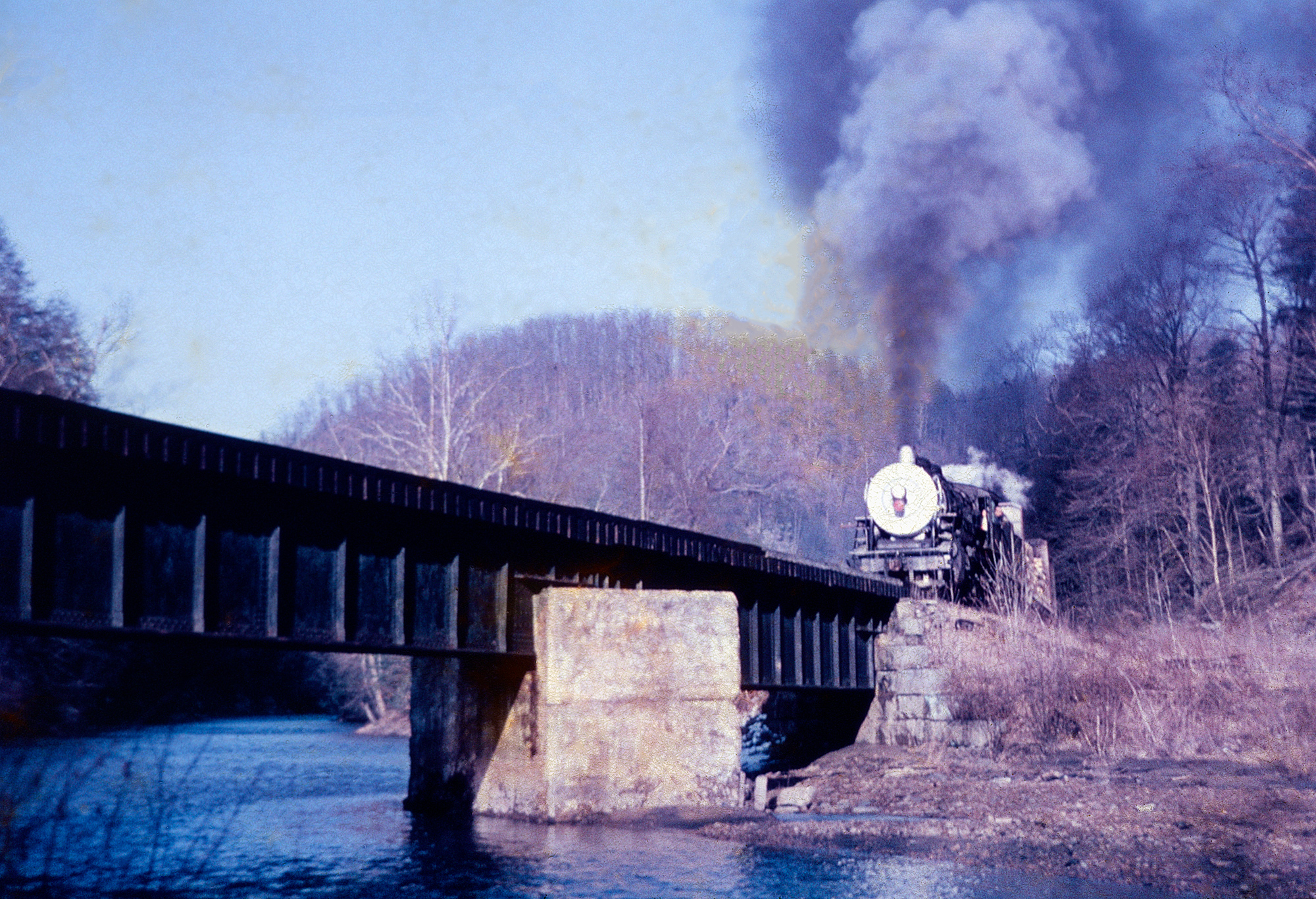 Buffalo Creek & Gauley 2-8-0 #4 is about to cross Sand Fork Trestle on a special photo run-by during the fall of 1964. Larry Fellure photo. American-Rails.com collection.
Buffalo Creek & Gauley 2-8-0 #4 is about to cross Sand Fork Trestle on a special photo run-by during the fall of 1964. Larry Fellure photo. American-Rails.com collection.Today
Over the years, the Elk River Railroad managed to stay afloat by generating modest revenue from the storage and refurbishment of CSX Transportation's rail cars at its Gassaway yard, which also housed its former offices.
Following the 1999 closure of the Avoca mine, speculation began to circulate regarding the possible resurrection of the Elk River's operations. This conjecture included visionary plans to rebuild the historic B&O route, extending all the way to Charleston. Such ambitious movements rippled a sense of anticipated excitement throughout the railway industry.
Sadly, not only did these promising ventures fail to materialize, but the 2010s also bore witness to the steady abandonment and removal of the esteemed Coal & Coke south of Gassaway. In a decisive move in March 2022, Elk River brought its operations to a halt, relegating its small ensemble of GP units to the care of the Durbin & Greenbrier Valley.
Despite this bleak narrative, there shines a beacon of hope for enthusiasts of the BC&G. Three of its steam locomotives have managed to stand the test of time, including the sterling 2-8-0 #4, originally purchased new. Currently, it is undergoing an extensive restoration at the Durbin & Greenbrier Valley since February, 2015, with plans to return it to service looming in the near future.
The locomotive, known by its nickname as "Old Slobberface" for its knack of leaking around its smokebox, has long been on display at the facility in Spencer and will be restored to operation by the D&GV.
It is slated to be returned to service and will likely operate on the former Western Maryland between Cass and Elkins.
Its sister steam locomotives, #13 and #14, also endure. #13 has found a home at the Age of Steam Roundhouse in Sugarcreek, Ohio, while #14 is cosmetically restored and on display at the Gaithersburg Community Museum in Gaithersburg, Maryland.
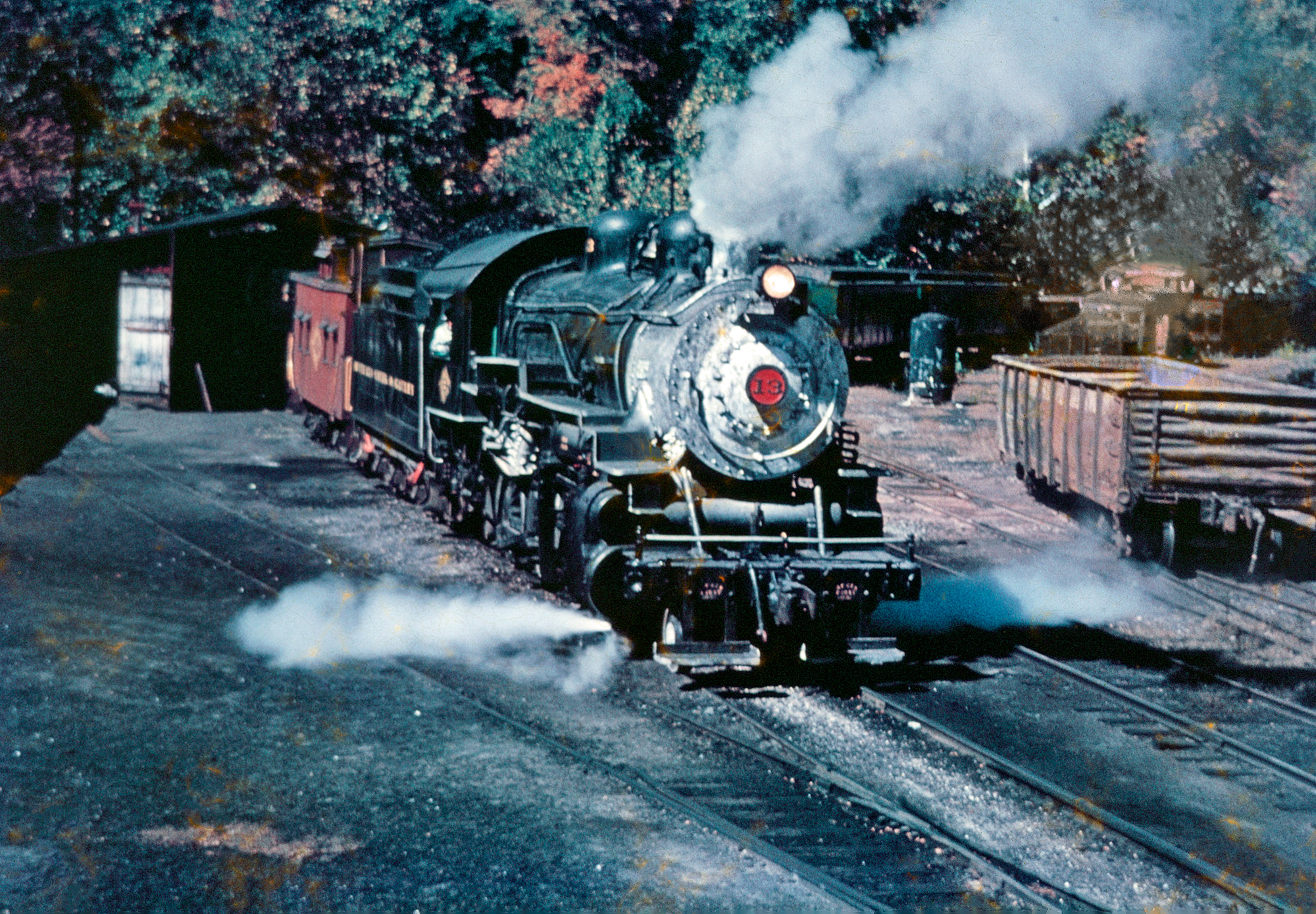 Buffalo Creek & Gauley 2-8-0 #4 clears out its cylinder cocks at the yard in Dundon, West Virginia during the fall of 1964. Larry Fellure photo. American-Rails.com collection.
Buffalo Creek & Gauley 2-8-0 #4 clears out its cylinder cocks at the yard in Dundon, West Virginia during the fall of 1964. Larry Fellure photo. American-Rails.com collection.In 2005 the BC&G again found a new life. That year the Buffalo Creek and Gauley Railroad Co-Operative was formed to refurbish the old railroad and operate a excursion train over the line.
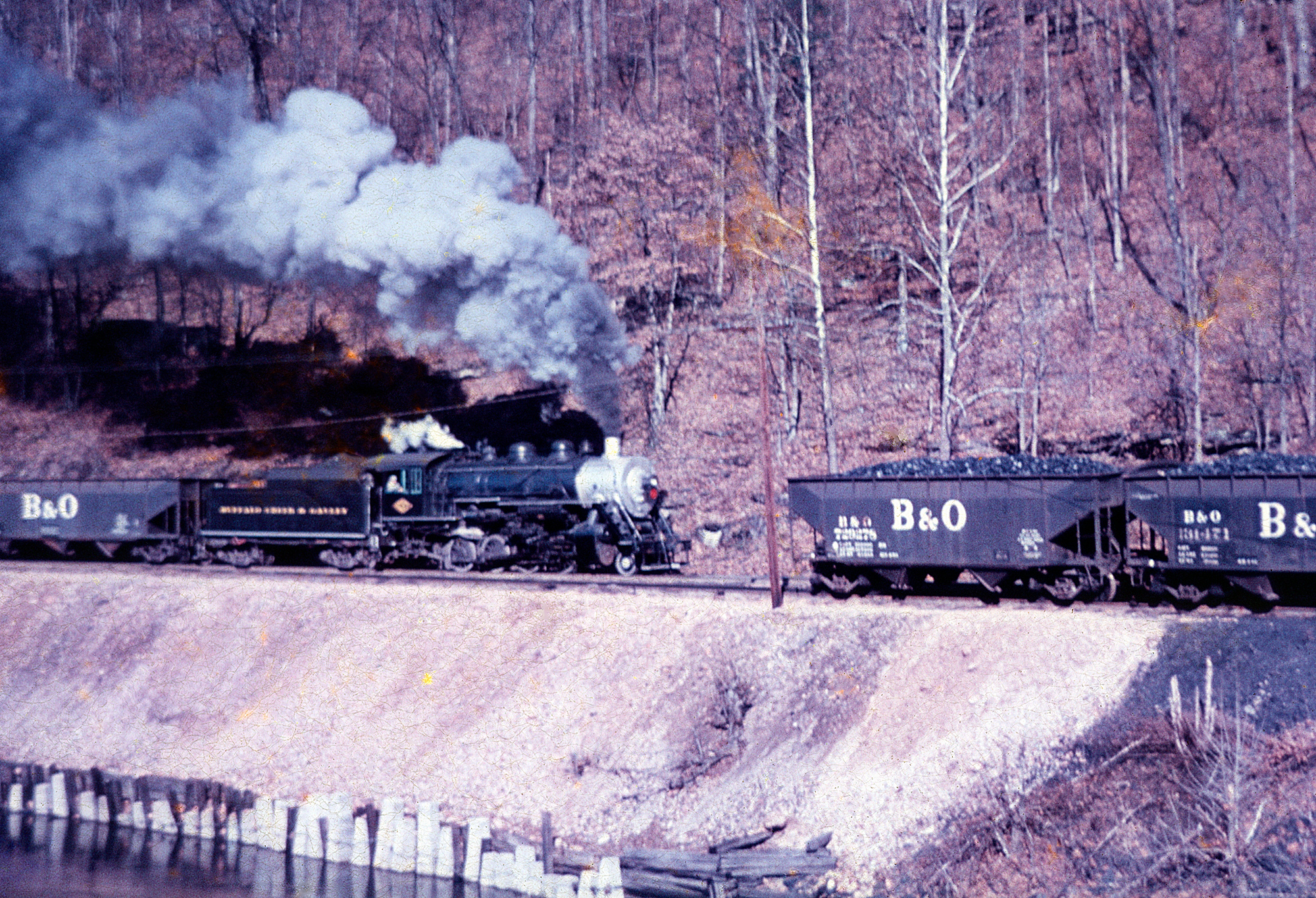 Buffalo Creek & Gauley 2-8-0 #4 pulls a cut of empties from the B&O interchange at Clay Junction, West Virginia during the fall of 1964. Larry Fellure photo. American-Rails.com collection.
Buffalo Creek & Gauley 2-8-0 #4 pulls a cut of empties from the B&O interchange at Clay Junction, West Virginia during the fall of 1964. Larry Fellure photo. American-Rails.com collection.Scenic Excursions
Under the organization's guidance the track was cleared and a new campground and lodge established on the site of the BC&G's old Dundon yard. Along with the campground and lodge the co-op was also able to acquire two cabooses for use in excursion service and a small GE 35-ton locomotive.
The dream was almost entirely self-funded from just a few volunteers although they were able to acquire a grant from the state of West Virginia to help in establishing the tourist line. Alas, however, the project stalled and quietly disappeared.
West Virginia stepped in and acquired the entirety of the old BC&G property in December, 2020. As of this writing the state currently only has plans to utilize the tracks for a railbiking operation.
It is interesting the state did not leave the connection in place to the BC&G at Dundon and acquire the old B&O's Coal & Coke Branch from that point to the Appalachian & Ohio connection at Gilmer.
Recent Articles
-
Arizona's - Wine Tasting - Train Rides
Jan 14, 26 02:04 PM
For those who want to experience the charm of Arizona's wine scene while embracing the romance of rail travel, wine tasting train rides offer a memorable journey through the state's picturesque landsc… -
Arkansas's - Wine Tasting - Train Rides
Jan 14, 26 01:57 PM
This article takes you through the experience of wine tasting train rides in Arkansas, highlighting their offerings, routes, and the delightful blend of history, scenery, and flavor that makes them so… -
Tennessee ~ Murder Mystery ~ Dinner Train Rides
Jan 14, 26 01:42 PM
Amidst the rolling hills and scenic landscapes of Tennessee, an exhilarating and interactive experience awaits those with a taste for mystery and intrigue. -
California ~ Murder Mystery ~ Dinner Train Rides
Jan 14, 26 01:26 PM
When it comes to experiencing the allure of crime-solving sprinkled with delicious dining, California's murder mystery dinner train rides have carved a niche for themselves among both locals and touri… -
Illinois ~ Murder Mystery ~ Dinner Train Rides
Jan 14, 26 01:13 PM
Among Illinois's scenic train rides, one of the most unique and captivating experiences is the murder mystery excursion. -
Vermont's - Murder Mystery - Dinner Train Rides
Jan 14, 26 12:57 PM
There are currently murder mystery dinner trains offered in Vermont but until recently the Champlain Valley Dinner Train offered such a trip! -
Massachusetts Dinner Train Rides On Cape Cod!
Jan 14, 26 12:20 PM
The Cape Cod Central Railroad (CCCR) has carved out a special niche by pairing classic New England scenery with old-school hospitality, including some of the best-known dining train experiences in the… -
Maine Dinner Train Rides In Portland!
Jan 14, 26 11:31 AM
While this isn’t generally a “dinner train” railroad in the traditional sense—no multi-course meal served en route—Maine Narrow Gauge does offer several popular ride experiences where food and drink a… -
Kentucky Dinner Train Rides In Bardstown!
Jan 13, 26 01:14 PM
The essence of My Old Kentucky Dinner Train is part restaurant, part scenic excursion, and part living piece of Kentucky rail history. -
Kansas Dinner Train Rides In Abilene!
Jan 13, 26 12:44 PM
If you’re looking for a heritage railroad that feels authentically Kansas—equal parts prairie scenery, small-town history, and hands-on railroading—the Abilene & Smoky Valley Railroad (A&SV) delivers. -
Michigan ~ Murder Mystery ~ Dinner Train Rides
Jan 13, 26 11:24 AM
Among the lesser-known treasures of this state are the intriguing murder mystery dinner train rides—a perfect blend of suspense, dining, and scenic exploration. -
Virginia's - Murder Mystery - Dinner Train Rides
Jan 13, 26 11:11 AM
Among the state's railroad attractions, murder mystery dinner trains stand out as a captivating fusion of theatrical entertainment, fine dining, and scenic travel. -
Arizona Dinner Train Rides At The Grand Canyon!
Jan 13, 26 10:59 AM
While the Grand Canyon Railway does not offer a true, onboard dinner train experience it does offer several upscale options and off-train dining. -
Georgia Dinner Train Rides In Nashville!
Jan 13, 26 10:27 AM
If you’ve ever wished you could slow down, trade traffic for jointed rail, and let a small-town landscape roll by your window while a hot meal is served at your table, the Azalea Sprinter delivers tha… -
Indiana Valentine's Train Rides
Jan 12, 26 04:27 PM
If you’ve ever wished you could step into a time when passenger trains were a Saturday-night treat and a whistle echoing across farm fields meant “adventure,” the Nickel Plate Express delivers that fe… -
Ohio Valentine's Train Rides!
Jan 12, 26 04:20 PM
The Hocking Valley Scenic Railway offers one of the region’s most atmospheric ways to experience the Hocking Hills area: from the rhythmic click of jointed rail to the glow of vintage coaches rolling… -
Wisconsin's - Wine Tasting - Train Rides
Jan 12, 26 03:10 PM
Wisconsin might not be the first state that comes to mind when one thinks of wine, but this scenic region is increasingly gaining recognition for its unique offerings in viticulture. -
California's - Wine Tasting - Train Rides
Jan 12, 26 02:34 PM
This article explores the charm, routes, and offerings of these unique wine tasting trains that traverse California’s picturesque landscapes. -
Wisconsin Scenic Train Rides In North Freedom!
Jan 12, 26 02:20 PM
The Mid-Continent Railway Museum is a living-history museum built around the sights, sounds, and everyday rhythms of small-town and shortline railroading in the early 20th century, what the museum cal… -
Vermont Scenic Train Rides In Burlington!
Jan 12, 26 01:18 PM
Today, GMRC is best known by many travelers for its Burlington-based passenger experiences—most famously the Champlain Valley Dinner Train and the sleek, limited-capacity Cocktails on the Rails. -
Maryland's - Murder Mystery - Dinner Train Rides
Jan 12, 26 01:03 PM
Maryland is known for its scenic landscapes, historical landmarks, and vibrant culture, but did you know that it’s also home to some of the most thrilling murder mystery dinner trains? -
Minnesota's - Murder Mystery - Dinner Train Rides
Jan 12, 26 12:17 PM
Murder mystery dinner trains offer an enticing blend of suspense, culinary delight, and perpetual motion, where passengers become both detectives and dining companions on an unforgettable journey. -
Vermont Dinner Train Rides In Burlington!
Jan 12, 26 12:09 PM
There is one location in Vermont hosting a dedicated dinner train experience at the Green Mountain Railroad. -
Connecticut Dinner Train Rides In Essex!
Jan 12, 26 10:39 AM
Connecticut's rail heritage can be traced back to the industry's earliest days and a few organizations preserve this rich history by offering train rides. The Essex Steam Train also hosts dinner-theme… -
Florida Scenic Train Rides In Parrish!
Jan 11, 26 10:26 PM
The Florida Railroad Museum (FRRM) in Parrish offers something increasingly rare in today’s rail landscape: a chance to ride historic equipment over a surviving fragment of an early-20th-century mainl… -
California's - Wine Tasting - Train Rides
Jan 11, 26 02:28 PM
This article explores the charm, routes, and offerings of these unique wine tasting trains that traverse California’s picturesque landscapes. -
Georgia's - Murder Mystery - Dinner Train Rides
Jan 11, 26 02:07 PM
In the heart of the Peach State, a unique form of entertainment combines the thrill of a murder mystery with the charm of a historic train ride. -
Colorado ~ Murder Mystery ~ Dinner Train Rides
Jan 11, 26 01:43 PM
Nestled among the breathtaking vistas and rugged terrains of Colorado lies a unique fusion of theater, gastronomy, and travel—a murder mystery dinner train ride. -
Minnesota Dinner Train Rides In Duluth!
Jan 11, 26 01:32 PM
One of the best ways to feel the region's history in motion today is aboard the North Shore Scenic Railroad (NSSR), which operates out of Duluth’s historic depot. -
Illinois Dinner Train Rides At Monticello!
Jan 11, 26 12:42 PM
The Monticello Railway Museum (MRM) is one of those places that quietly does a lot: it preserves a sizable collection, maintains its own operating railroad, and—most importantly for visitors—puts hist… -
Alabama's - Wine Tasting - Train Rides
Jan 10, 26 09:29 AM
While the state might not be the first to come to mind when one thinks of wine or train travel, the unique concept of wine tasting trains adds a refreshing twist to the Alabama tourism scene. -
Maryland Dinner Train Rides At WMSR!
Jan 10, 26 09:13 AM
The Western Maryland Scenic Railroad (WMSR) has become one of the Mid-Atlantic’s signature heritage operations—equal parts mountain railroad, living museum, and “special-occasion” night out. -
Arkansas Dinner Train Rides On The A&M!
Jan 10, 26 09:11 AM
If you want a railroad experience that feels equal parts “working short line” and “time machine,” the Arkansas & Missouri Railroad (A&M) delivers in a way few modern operations can. -
South Dakota's - Murder Mystery - Dinner Train Rides
Jan 10, 26 09:08 AM
While the state currently does not offer any murder mystery dinner train rides, the popular "1880 Train" at the Black Hills Central recently hosted these popular trips! -
Wisconsin's - Murder Mystery - Dinner Train Rides
Jan 10, 26 09:07 AM
Whether you're a fan of mystery novels or simply relish a night of theatrical entertainment, Wisconsin's murder mystery dinner trains promise an unforgettable adventure. -
Missouri's - Murder Mystery - Dinner Train Rides
Jan 10, 26 09:05 AM
Missouri, with its rich history and scenic landscapes, is home to one location hosting these unique excursion experiences. -
Washington ~ Murder Mystery ~ Dinner Train Rides
Jan 10, 26 09:04 AM
This article delves into what makes murder mystery dinner train rides in Washington State such a captivating experience. -
Kentucky Scenic Train Rides At KRM!
Jan 09, 26 11:13 PM
Located in the small town of New Haven the Kentucky Railway Museum offers a combination of historic equipment and popular excursions. -
Washington "Wine Tasting" Train Rides
Jan 09, 26 08:53 PM
Here’s a detailed look at where and how to ride, what to expect, and practical tips to make the most of wine tasting by rail in Washington. -
Kentucky's - Wine Tasting - Train Rides
Jan 09, 26 08:21 PM
Kentucky, often celebrated for its rolling pastures, thoroughbred horses, and bourbon legacy, has been cultivating another gem in its storied landscapes; enjoying wine by rail. -
Kentucky's - Murder Mystery - Dinner Train Rides
Jan 09, 26 01:12 PM
In the realm of unique travel experiences, Kentucky offers an enchanting twist that entices both locals and tourists alike: murder mystery dinner train rides. -
Utah's - Murder Mystery - Dinner Train Rides
Jan 09, 26 01:05 PM
This article highlights the murder mystery dinner trains currently avaliable in the state of Utah! -
North Carolina Dinner Train Rides At NCTM!
Jan 09, 26 12:51 PM
Tucked into the Piedmont town of Spencer, the North Carolina Transportation Museum is the kind of place that feels less like a typical museum and more like a living rail yard that never quite stopped… -
Tennessee Dinner Train Rides At The TVRM!
Jan 09, 26 12:39 PM
Tucked into East Chattanooga, the Tennessee Valley Railroad Museum (TVRM) is less a “museum you walk through” and more a railroad you step aboard. -
New York Scenic Train Rides On The A&A!
Jan 09, 26 11:20 AM
The A&A is both a common-carrier short line moving freight and a heritage railroad hosting popular excursion trains, all on the same storied right-of-way. -
Pennsylvania Scenic Train Rides In Hollidaysburg!
Jan 09, 26 11:14 AM
Tucked into the Juniata River valley just south of Altoona, the Everett Railroad offers one of the most approachable—and photogenic—heritage-rail experiences in Pennsylvania -
Montana Dinner Train Rides Near Lewistown!
Jan 08, 26 03:03 PM
The Charlie Russell Chew Choo turns an ordinary rail trip into an evening event: scenery, storytelling, live entertainment, and a hearty dinner served as the train rumbles across trestles and into a t… -
Alabama's - Murder Mystery - Dinner Train Rides
Jan 08, 26 02:19 PM
There is currently one location in the state offering a murder mystery dinner experience, the Wales West Light Railway! -
Rhode Island's - Murder Mystery - Dinner Train Rides
Jan 08, 26 01:43 PM
Let's dive into the enigmatic world of murder mystery dinner train rides in Rhode Island, where each journey promises excitement, laughter, and a challenge for your inner detective. -
Florida's - Wine Tasting - Train Rides
Jan 08, 26 01:13 PM
Wine by train not only showcases the beauty of Florida's lesser-known regions but also celebrate the growing importance of local wineries and vineyards.

